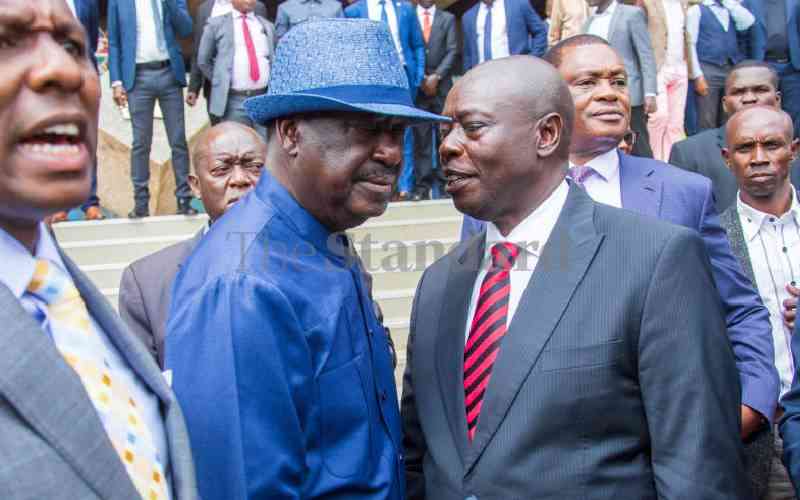</xml>
<style>
/* Style Definitions */
table.MsoNormalTable
{mso-style-name:"Table Normal";
mso-tstyle-rowband-size:0;
mso-tstyle-colband-size:0;
mso-style-noshow:yes;
mso-style-priority:99;
mso-style-qformat:yes;
mso-style-parent:"";
mso-padding-alt:0in 5.4pt 0in 5.4pt;
mso-para-margin-top:0in;
mso-para-margin-right:0in;
mso-para-margin-bottom:10.0pt;
mso-para-margin-left:0in;
line-height:115%;
mso-pagination:widow-orphan;
font-size:11.0pt;
font-family:"Times New Roman","serif";
mso-ascii-font-family:"Times New Roman";
mso-ascii-theme-font:minor-latin;
mso-fareast-font-family:"Times New Roman";
mso-fareast-theme-font:minor-fareast;
mso-hansi-font-family:"Times New Roman";
mso-hansi-theme-font:minor-latin;
mso-bidi-font-family:"Times New Roman";
mso-bidi-theme-font:minor-bidi;}
</style>
Ever since the Jubilee government romped into
power in 2013 the country has witnessed positive economic changes albeit on
deficit spending. As it is, the economic prospects for example of LAPSSET (Lamu
Port, Sudan and Ethiopia transport corridor) and SGR (Standard Gauge Railway)
are beginning to take shape.It’s evident that the LAPSSET and SGR underlie
the significance of real sustainable growth. However, underpinning Kenya’s 53 years
of economic instability are the following precipitated problems namely: - debts
upon debts, greed, covetousness, corruption embedded in the psyche of the
country’s socio-economic and political structure, inflation rate of 6.45%,
Kenya’s external debt estimated at 3.2 trillion and budget deficit for
2016/2017 at $6.96 billion
Notwithstanding the above challenges, the
economy is resilient. It hovers between the growth rate of 5.8-6%.
Discouragingly, Kenya is ranked at position 157 globally in terms of economic
performance index the GDP per capita stands at $1,800 and again, the external
debt averages at 619.28 billion (this is between 2000-2016) reaching an all-time
high.
Domestically, a sign of exponential growth can
be seen, coupled with great railway engineering works.
The construction is confronted with enormous
physical difficulties like land acquisition and compensation to natives. The
completion of SGR will fast track and increase commerce in numerical form by
comparing the value of export as a result from Kenya now with the old railway
system 100 years ago. Goods that found market after two weeks will do so in
four days.
Standard gauge railway as was old railway system
will do away with the exclusiveness of people and promote doctrine of equality
of mankind. It will continue to educate people enabling them to travel cheaply
with comfort to visit headquarters of civilization and prosperity.
Kenya is heavily indebted to her bilateral
partners hence the reason as to why it should not throw caution to the wind.
Deficit spending as a big dose is heavily taxing ordinary Kenyans. Year in year
out deficit spending has been the hallmark of Kenya’s fiscal
budget.
To quote Robert Borrud, in his book “like a
bulging wall, will you survive the 1990 economic crush?”
He says:-
Likewise many businesses decided to throw
caution to the wind during this time and get their piece of the credit pie;
increased debt was taken on as a means to boost expansion and to maximize
profit, short term profits especially in quarterly reports became an obsession
rather than concern for long term growth and health of company. Again the same
attitude dominated: get most out of life now.
Deficit spending by government on mega projects
has infected quite a good number of Kenyans. Deficit spending means spending or
expenditure of money not from one’s pocket but from a lender or financial
institution like banks. It’s basically living beyond our means.
Today the gradual change in the status of the
building societies and their deposits illustrate the tendency for the boundary
to shift. Manifestly so, construction industry is caught up in the web of deficit
spending to finance its activities.
The disadvantage of the deficit spending is that
it gives the borrower the elevated sense of affluence hence people think highly
of them as monied (rich).
However, this false sense of elevation leads to
impulse expenditure that diverts funds, leading to longevity in servicing debts
and huge accrued interests, leaving white elephant projects.
Stay informed. Subscribe to our newsletter
Untapped natural resources (for example oil, is
a solid investment resource to boost country’s foreign exchange earnings and
boost economy)
Another highly regrettable aspect is debt
defaults and theft of large sums of money, which may lead to the folding up of
the savings and loans industry, and hence collapse of the banks.
A reason for optimism however is that, the climate
for investment in Kenya is changing for the better. If the deficit spending is
done prudently, the country is set to be a preferred destination for investment
and an economic boom.
The assenting to law by President Kenyatta of
Banking Amendment Act is a relief to deficit spenders. It caps banks to offer
fixed rate of interest on money borrowed. My question is, is it a way of trying
to control money supply indirectly? The principle behind this idea is that
money varies inversely with interest rates. Higher interest rates tend to
reduce the demand for money because they increase the opportunity cost of
holding money.
With nominal interest rates across banks, the
burden of servicing won’t be onerous.
As a country though, the solution to Kenya’s debt
is to approach an international agency to take over claims from banks, buying
the debt at a discount. The debt could then be restructured to pass on the
benefit of discount to the debtors in future.
 The Standard Group Plc is a
multi-media organization with investments in media platforms spanning newspaper
print operations, television, radio broadcasting, digital and online services. The
Standard Group is recognized as a leading multi-media house in Kenya with a key
influence in matters of national and international interest.
The Standard Group Plc is a
multi-media organization with investments in media platforms spanning newspaper
print operations, television, radio broadcasting, digital and online services. The
Standard Group is recognized as a leading multi-media house in Kenya with a key
influence in matters of national and international interest.
 The Standard Group Plc is a
multi-media organization with investments in media platforms spanning newspaper
print operations, television, radio broadcasting, digital and online services. The
Standard Group is recognized as a leading multi-media house in Kenya with a key
influence in matters of national and international interest.
The Standard Group Plc is a
multi-media organization with investments in media platforms spanning newspaper
print operations, television, radio broadcasting, digital and online services. The
Standard Group is recognized as a leading multi-media house in Kenya with a key
influence in matters of national and international interest.








